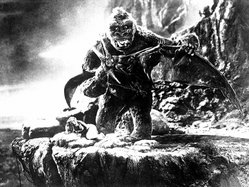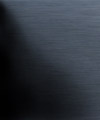King Kong
King Kong is the name of a 1932 novel; and a ground breaking 1933 film classic, two remakes (1976, 2005), and assorted sequels and ephemera associated with the above. more...
It is also the name assigned to the central character from these books and movies--a giant (25-foot) male gorilla who lives on the fictional and Anachronical "Skull Island" in the South Pacific (just how a gorilla came to live in the South Pacific is never explained), along with other over-sized animals such as snakes, pterosaurs and dinosaurs. more...
Captured by American explorers, he is taken to New York City and exhibited. He escapes and climbs the Empire State Building (World Trade Center in the 1976 movie) where he is shot and killed by aircraft. Key characters include promoter Carl Denham, and female lead Ann Darrow.
The 1932 novel
The original novel was written by Delos W. Lovelace, with the story credited to Edgar Wallace and Merian C. Cooper. Apparently Cooper was the key creative influence. In an interview, comic book author Joe DeVito explains:
- From what I know, Edgar Wallace, a famous writer of the time, died very early in the process. Little if anything of his ever appeared in the final story, but his name was retained for its salability.
- King Kong was Cooper’s creation, a fantasy manifestation of his real life adventures. As many have mentioned before, Cooper was Carl Denham. His actual exploits rival anything Indiana Jones ever did in the movies.
According to DeVito's research, the novel and original film are very close, and the characters virtually identical:
- The main differences are that in the novel, Englehorn’s ship is called the Wanderer, as opposed to the Venture; the famous spider scene that was cut out of the movie remains in the novel, as well as the appearance of one or two triceratops that chase the men onto the log. If you notice in the film, all the men are running like crazy onto the log and are frantically looking behind them (now you know why). There is a promotion still from the original movie that shows a ceratopsian on the right side chasing the men as they crowd onto the log, but I’m not sure it was actually a full sequence that was edited out. Also, in the book Kong is chained in a steel cage when in NYC as opposed to standing atop a steel scaffold.
- The main thing missing in the novel that was in the movie is that Kong does not destroy a subway train. This was added to the screen version because the initial filming of the movie ended with thirteen reels and Cooper didn’t want to jinx himself, so they shot a fourteenth reel, which was Kong clobbering the subway car. Even so, I think the final version seen by the public had only twelve reels.
The novel, which was published in December of 1932, should be regarded as a novelization of the now-classic movie (which debuted in March of the following year) which credited Wallace and Cooper--but not Lovelace--as its writers. The original publisher was Grosset & Dunlap. Paperback editions by Bantam (U.S.) and Corgi (U.K.) came out in the 1960s, and it has since been republished by Penguin and Random House.
In 1933, Mystery Magazine published a King Kong serial under the named of Walter F. Ripperger. This is unrelated to the 1932 novel.
Official filmography
- King Kong (1933). The original, classic film. Remembered for its pioneering special effects using stop-motion models and evocative story, yet criticized for its depiction of the Skull Island tribespeople--not to mention gorillas--as savages.
- Son of Kong (1933). A sequel released the same year that was an instant box office flop. It concerns a return expedition to Skull Island that discovers Kong's albino son.
- Japanese King Kong (1933) (Wasei Kingu Kongu, 和製キングコング). A little-known Japanese clone of the original King Kong produced by company Shochiku Kinema.
- King Kong Appears in Edo (1938) (Edo ni arawareta Kingu Kongu, 江戸に現れたキングコング). An enigmatic Japanese-made monster/period piece by company Zensho Kinema in which King Kong attacks medieval Edo (modern Tokyo), and also Japan's first kaiju (giant monster) film. Unfortunately, the film has been lost since its theatrical run in 1938, but rare photos available in books in Japan prove this film's existence. Fuminori Ohashi, who would go on to create the suit for the titular monster in Godzilla (1954), created the special effects for this film.
- King Kong vs. Godzilla (1962). A film produced by Toho Studios in Japan. It brought the titular characters to life (the first time for both characters to be in a film in color) via the process of suitmation.
- King Kong Escapes (1967). Another Toho film in which Kong faces both a mechanical double, dubbed Mechani-Kong, and a giant theropod dinosaur known as Gorosaurus (who would appear in Toho's Destroy All Monsters the following year).
- King Kong (1976) A remake by film producer Dino De Laurentiis and director John Guillermin. Jessica Lange and Jeff Bridges starred. The film was generally panned by critics at the time, but its reputation has improved with time, and it was eventually a commercial success.
- King Kong Lives (1986). Starring Linda Hamilton, a sequel by the same production company as the 1976 film which involves Kong surviving his fall from the sky and requiring a coronary operation.
- King Kong (2005). A Universal Pictures remake of the original. Directed by Peter Jackson, best known for directing the Lord of the Rings trilogy. The most recent incarnation of Kong is also the longest, running three hours and ten minutes.
Late in 2005, the BBC and Hollywood trade papers reported that a 3D stereoscopic version of the 2005 film was being created from the animation files, and live actors digitally enhanced for 3D display. This may be just an elaborate 3D short for Universal Studios Theme Park, or a digital 3D version for general release in 2006.
Television
- The King Kong Show (1966). In this cartoon series, the famous giant ape befriends the Bond family, with whom he goes on various adventures, fighting monsters, robots, mad scientists and other threats. Produced by Rankin/Bass, the animation was provided in Japan by Toei Animation, making this the very first anime series to be commissioned right out of Japan by an American company. This was also the cartoon that resulted in the production of Toho's Godzilla vs. the Sea Monster (originally planned as a Kong film) and King Kong Escapes.
- Kong: The Animated Series. Set after the events of King Kong falling off the skyscraper and is cloned by a female scientist
Read more at Wikipedia.org



